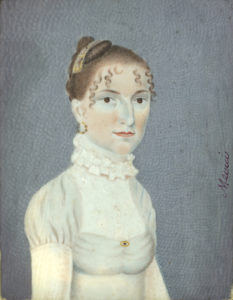Antonio and Nina Meucci
The husband and wife team of artists, Antonio and Nina Meucci, announced their arrival in New Orleans in 1818 in a newspaper advertisement offering to paint portraits and miniatures “of every dimension.”

Courtesy of The Historic New Orleans Collection
Portrait of an unknown lady. Meucci, Antonio (Artist)
The husband-and-wife team of artists Antonio and Nina Meucci announced their arrival in New Orleans in 1818 with a newspaper advertisement, offering to paint portraits and miniatures “of every dimension.” The Meuccis also promoted their “academy for young ladies & gentleman, at [their] dwelling in Bourbon St., in the house belonging to Mr. Honoré Landreaux, near the Orleans Theatre, No. 92.” Antonio was from Italy, and made frequent claims about his academic training and professional associations in Europe. Nina was from Spain. It is not known if she was an established artist before the marriage or if she learned the trade from her husband. Their style followed the international conventions of early nineteenth-century miniature painting, characterized by a dot-and-stipple technique, plain background, and emphatic modeling, all necessary to establish likenesses on such a small scale.
The Meuccis were peripatetic, working in Charleston, South Carolina, where they again opened a private drawing academy, between 1821 and 1822. Instruction was offered in several media and genres: “Drawing in Crayons, Miniature Painting, Landscape, Flower Painting … and also the true manner of Painting on Velvet and Satin.” On April 4, 1822, a notice in the Charleston Courier announced Antonio’s elegant painting of the “Death of Hias … 15 feet long, and 13½ high.” The press had described it about a week earlier as “a very interesting subject, taken from Grecian fable.”
Although not all their travels have been documented, in 1823 the Meuccis were in New York City. They appear in Salem, Massachusetts, in 1825, and again in New York in 1826. There is circumstantial evidence that they were in Richmond and Portland, Maine, as well. They returned to New Orleans in 1826, and exhibited “a great variety of miniatures and other style,” possible paintings on velvet, at Hewlett’s Exchange Coffee House and Davis’ Coffee House. Like many artists of the era, in addition to teaching, the Meuccis worked as restorers. They seemed unusually selective, offering to repair “all likenesses painted by themselves, which may be injured by the weather, damp or otherwise.” By 1827, Antonio was painting theatrical scenery. He is listed in the New Orleans City Directory as a scenery painter for the Théâtre de Orleans, and a “Scottish View” was noted in the press as having “the most agreeable perspective.” It was at this time that the Meuccis taught a young Creole named Julien Hudson how to paint miniatures. Hudson, a free person of color, went on to become a recognized portrait artist.
Records suggest that the Meuccis traveled to Havana, Cuba, and Kingston, Jamaica. By 1830, they were in Cartagena, Columbia. The couple’s daughter, Sabina Meucci (ca. 1805–1884), lived in Cartagena with her husband, Richard Souter. At this point, Nina’s name disappears from advertisements. Antoino painted at least twelve miniatures of Simón Bolivar. Don Jose Maria Espinosa, Cartagena’s leading miniaturist, charged Meucci with plagiarism. Whether Meucci went into exile or not, he advertised in Rionegro, Colombia in 1831, in Popayán, Colombia in 1832, and in Lima, Peru on February 27, 1834. No record of Meucci has surfaced beyond 1837, though family records suggest that he died in Lima or Guayaquil, Ecuador, in either 1847 or 1852.
